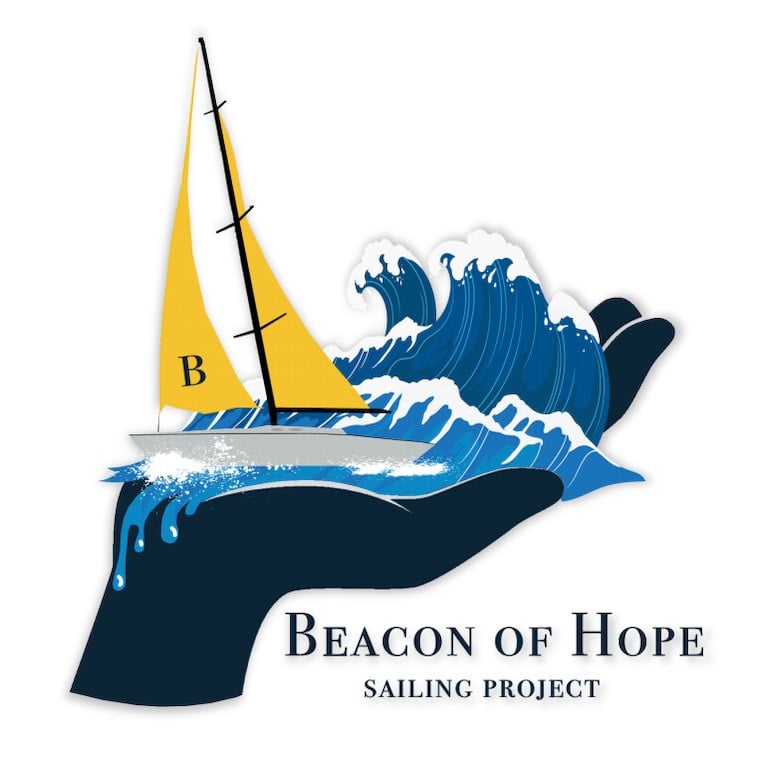Displaying items by tag: Cruising
ARC+ 2021, World Cruising Club’s two-stage transatlantic rally to Grenada, set sail today from Las Palmas de Gran Canaria with 70 boats spirited away by the tradewinds bound for Mindelo Marina in Cape Verde for the first leg. Years of planning, months of preparations, and days of checking off the jobs list has gone in ahead of today's departure, which saw crew from 24 different nationalities heading off to begin their Atlantic adventure.
Three Irish entries were among today's departures; two multihulls and a monohull yacht.
Conor Haughey is the skipper of Hibernian, a Dublin-based Moody 54DS. Brendan Cahill set sail in Lir, a Lagoon 450 as did County Kerry's Brian O'Sullivan and Frances Clifford in the Lagoon 46 Navillus.
 Brian O'Sullivan and Frances Clifford's Lagoon 46 Navillus
Brian O'Sullivan and Frances Clifford's Lagoon 46 Navillus
The rally began with a programme of pre-departure activities to ensure the boats and crews were suitably ready for departure. From the end of October, Las Palmas Marina has become a colourful sight with yachts dressed overall and rally flags flying. ARC+ has had a real family feel this year with 17 boats sailing with children on board and a total of 33 kids set to enjoy their first taste of Atlantic sailing on the rally.
Following COVID-secure protocols, organised activities for participants prior to departure have included a range of seminars, crew suppers and drinks events creating a great community spirit amongst the sailors. Rally organisers World Cruising Club have supported their preparations with one-to-one safety checks of boat equipment and smoothing their logistics, and the many marine businesses around the city have assisted with getting the boats ship shape for departure.
There was great excitement around the docks of Las Palmas marina as start day dawned and lines were slipped to head out to the starting area. “We are really looking forward to the departure. We deferred from last year’s rally so it seems like we’ve been waiting such a long time so we just can’t wait to get going!” said Derek Frame, British owner of the Wauquiez 47PS Delite, “It was a really good Skippers Briefing yesterday and we’ve had great advice and help from World Cruising Club, so I feel we are prepared and ready go now.”
Stephan Friedel, skipper of the German Catana 531 Rob Roy III says that he has enjoyed his time here but after four weeks in Gran Canaria it will be good to start. “We want to get going now and everyone is ready and wants to get into warmer tropical weather. It’s time to go now it’s a bit cooler here! My first Atlantic crossing was in 1998, but this will be my first rally and my first as skipper - a dream that I’ve had since I was a young boy, so I’m excited that finally it has come true!”
As forecast, the winds on start day provided a rock and roll departure with 15-20knts blowing steadily in the starting area from the North East and a significant swell running outside the shelter of the port. The countdown began from ARC+ Rally Control onboard ARC yacht Vahine (FIN) acting as committee vessel for the ARC+ starts. At 12:45, the multihulls were led away by the impressive Outremer 51 Piment Rouge (FRA) and Neel 47 Bigbird (USA) flying across the line close to the shore to the delight of the spectators strolling along the Avenida Marítima.
At 13:00 it was the turn of monohulls with the Cruising Division setting off on the 865nm passage to Mindelo. It was the Beneteau Oceanis 40, Sala from Norway sailed by the Christensen family under the watchful eye of their weather expert Mads Liestøl Christensen who were first to cross the line. The Irish Moody 54 DS Hibernian skippered by Conor Haughey was next and another Norwegian family boat, Albicilla, crossed in third place with a big cheer on board. The start was quite a sight as the fleet bounced through the ocean waves and bid farewell to the city of Las Palmas de Gran Canaria.
For their first night at sea, moderate trade winds are expected to whisk the fleet away from Gran Canaria before decreasing as the yachts get closer to the Cape Verde Islands in the coming days.
On arrival in Mindelo, there is an exciting programme for crews to explore ashore and the stopover has been extended to give crews more time to enjoy the islands. The first boats are expected from Friday 12 November and will receive a warm welcome from the teams of Marina Mindelo staff and World Cruising Club.
Following the stopover, ARC+ has a new Caribbean destination this year and the fleet will be sailing to Camper and Nicholsons Port Louis Marina on the island of Grenada. The re-start from Mindelo will be on Friday 19 November.
All the yachts are equipped with a YB Tracker, regularly broadcasting their position to the online Fleet Viewer and YB Races app for friends and family to follow the fleet. Tales of fishing triumphs and tradewind sailing will also be sent to the World Cruising Club website, as participants share their ocean adventures.
There are three transatlantic departures from Las Palmas de Gran Canaria organised by World Cruising Club under the Atlantic Rally for Cruisers banner: ARC+ 2021, ARC 2021 and ARC January 2022.
Galway Bay Lambs Week Cruise Succeeds With Block Bookings
With an impressive and eclectic fleet of 46 boats from West Coast ports which ranged from Clew Bay to the north to Kilrush in the Shannon Estuary to the south - in addition to the many harbours and anchorages within Galway Bay itself - last weekend's five day Lambs Week Cruise organised by Galway Bay Sailing Club took full advantage of the improving weather to take in Rossaveal, Kilronan on Inishmor in the Aran Islands, and Roundstone, the very essence of Connemara.
The theme of the five-day Lamb's Week – which began with most boats assembling at Rossaveal Marina on the Thursday evening – was accessibility, and the willing provision of encouragement for the less-experienced.
But one of the challenges in organizing a heavily-subscribed Cruise-in-Company of this nature in a very special place like the greater Galway Bay area is that while the number of very useful marinas at strategic ports is increasing, the number of pontoon berths available for visitors – even with rafting-up – is limited, and extra boats will have to find secure moorings, or rely on their own anchors.
 It's one very complicated piece of coastline, but in experienced company it becomes a cruising paradise
It's one very complicated piece of coastline, but in experienced company it becomes a cruising paradise
Any proper cruising boat should of course have adequate ground tackle. However, the problem of confined space in the best anchorages – often with established moorings cluttering the sea-bed - together with the rich proliferation of seaweed, means that your anchor can become irretrievably fouled, or else it doesn't take hold at all as it sits on a bed of kelp.
GBSC came up with a solution of breath-taking simplicity. They made a batch of concrete mooring blocks at their Renville base near Oranmore at the head of the Bay, and with the skilled services of Ocean Crest Marine, they'd a complete set of these additional reliable moorings in place when the first of the fleet arrived in Aran through Friday afternoon and evening with a race from Rossaveal in a brisk sou'wester which experienced the last of the Cruise's serious rain.
 Problem: Shortage of Visitors' Moorings? Solution: Galway Bay SC simply made their own, and sent them on ahead of the fleet.
Problem: Shortage of Visitors' Moorings? Solution: Galway Bay SC simply made their own, and sent them on ahead of the fleet.
 Rossaveal was the assembly port for a diverse fleet – this is the Contessa 32 of Frankie Leonard ready for the off.
Rossaveal was the assembly port for a diverse fleet – this is the Contessa 32 of Frankie Leonard ready for the off.
Kilronan became the fleet base throughout Saturday and into Sunday morning (it will be the location for WIORA Week 2023), and with such numbers in port, it seemed natural to provide a race right round the Aran Islands for those with the need for a further spot of competition, though some thought they'd done quite enough racing with Friday's windward slog.
 The quayside-berthed section of the fleet in Kilronan. Photo: Declan Dooley
The quayside-berthed section of the fleet in Kilronan. Photo: Declan Dooley
 Racing the Atlantic during Lamb's Week, Aaron O'Reily's Kondon Buntz in foreground.
Racing the Atlantic during Lamb's Week, Aaron O'Reily's Kondon Buntz in foreground.
Twenty-one boats of all shapes and sizes – in other words, nearly half of the fleet – took on the challenge in a sunny 18 knots westerly, the highlight being the spectacular sight of the Cliffs of Moher as they made the southerly turn of the circuit at Finnis Rock. To add to the sport, it had been made a pursuit race, with the first boat – Patrick McCarthy's Snapper – getting away at 11:00 hrs, while the Queen of the Fleet, Tomas Furey's speedy big Rhodocar, was held back until 11:44.
 Winning style – Mark Wilson's Scorpio sweeps along to a close victory
Winning style – Mark Wilson's Scorpio sweeps along to a close victory
First to finish – and winner of the King of Lambs Trophy – was Mark Wilson's Sigma 33 Scorpio from GBSC. But if anything it's the handicapper, Fergal Lyons, who deserves a Gold Medal at the very least, as Scorpio at 14:16:53 crossed the final line only 30 seconds ahead of Jackie Cronin's Jimmy Burn from Kilrush, which in turn was five seconds ahead of Conor Owens' Sealion (GBSC), while only one second behind that in fourth was Stephen O'Gorman's Green Monkey (GBSC).
 Brothers Conor and Fergal Lyons aboard Out of the Blue. It was Fergal who produced the exceptionally well-judged handicaps.
Brothers Conor and Fergal Lyons aboard Out of the Blue. It was Fergal who produced the exceptionally well-judged handicaps.
This was pursuit racing at its very best, as their starting times had been Scorpio: 11:23; Jimmy Burn: 11:33; Sealion: 11:14; and Green Monkey 11:42. It was superb sport which greatly impressed the Aran Islanders, and set the tone for a boisterous night in Kilronan. Yet they still managed to be underway in a reasonably timely manner on the Sunday morning for the calm hop northwestward to Roundstone, one of the Connacht coast's great cruising passages as it involves a rewarding mixture of open ocean sailing and reasonably intricate pilotage to conclude in a little port which rates highly on any discerning cruising person's dream list.
There was time for a lunchtime break and swims and shore visits at MacDara's Island – GBSC Commodore John Shorten likened the procession of the fleet to a miniature of the approaches to the Suez Canal – before going on into the embrace of Roundstone, with the partying ashore rounded out by a barbecue in the Village Hall, following which the overnight fog was successfully negotiated by Martin the ever-helpful unofficial Roundstone harbourmaster to ensure that everyone got safely back to the right boat.
 Part of the fleet in Roundstone
Part of the fleet in Roundstone They brought the summer back with them – sunset at the return to Rossaveal
They brought the summer back with them – sunset at the return to Rossaveal
The morning brought total summer with bright sunshine and the temperature pushing towards 25 degrees as the majority headed back towards Rossaveal, while others had longer passages north and south after a hugely successful event which will be remembered as one of the highlights of the 2021 season on the west coast.
As ever with an event of this kind, there were many movers and shakers and volunteers involved, but if you suggested that John Shorten and Cormac Mac Donncha in particular - and the likes of Pierce Purcell and others - had something to do with this remarkable happening, you wouldn't be far off target.
 The King of Lambs – Mark Wilson's Sigma 33 Scorpio was crewed by Cian Conroy, Cronan Quirke, Damian Burke, Aoife Macken, and Iso.
The King of Lambs – Mark Wilson's Sigma 33 Scorpio was crewed by Cian Conroy, Cronan Quirke, Damian Burke, Aoife Macken, and Iso.
The Cruising Association of Ireland's Whistle Stop Cruise of the east coast of Ireland overnighted at Wicklow Harbour.
The association says the cruise has attracted a fleet of 23 boats since it commenced on Tuesday 22nd June.
The Cruising Association also intends to visit Arklow, Greystones, Skerries, Malahide and Dublin over the course of the six-day event.
Over 50 sailors are involved with 'enthusiastic cooperation from marinas and sailing clubs'.
On Saturday 27 June the cruise is headed for Dublin City. Dublin Port will open the Tom Clarke bridge and the fleet will berth at the long pontoon near the 3 Arena on the River Liffey.
The Cruising Association, through its local representatives, has helped to make cruising to France easier, post-Brexit.
Since leaving the EU, boats arriving in France from the UK or Channel Islands are required to sail to one of a small number of "Ports of Entry" (mainly the ferry ports) and search out the relevant authorities - usually the Police aux Frontières - to register the arrival of their boat and crew.
This same process of going through a Port of Entry would also be necessary before departing France for the UK or Channel Islands (or indeed any non-Schengen country), presenting CA members, and other sailors coming from the UK to France, with a potential problem for many passages.
Two of the Cruising Association's Honorary Local Representatives (HLRs) have been aware of this extra challenge to cruising for some time and have been working with the local marinas, the marina associations and local officials to try and simplify it.
Now, as a direct result of their efforts, the French government has announced a process to allow entry at any French port.
A form is now available from web sites that can be downloaded, completed and submitted by email to the local administrative Port of Entry prior to arrival. Providing all is acceptable, boats may then enter another port. This is already underway for Le Havre and other ports will follow on rapidly.
For this week's Sailing on Saturday we take a look back eight years when WM Nixon cruised from Ireland to the Outer Hebrides in the 36-foot vintage restored sloop Ainmara
#hebrides – August is almost upon us. The heat has been fierce, and the summer season has been busy. Despite some blips in the weather, civilised folk will be thinking of sailing away from it all for a while. North and west perhaps, in the hope of finding uncrowded and beautiful places which may be cooler. The Western Isles, the Outer Hebrides, are calling us away.
Certainly they did so in August last year, but not for reasons of heat. On the contrary, the jetstream lay persistently along Ireland's south coast, and July's weather here was appalling. But the word came back that up in the Hebrides, they were already thinking of water shortages as the sun shone on and on.
We had contemplated taking the 1912-built 36ft Kearney yawl Ainmara to southwest Ireland for her Centenary cruise. But as owner Dickie Gomes is an enthusiast for the west coast of Scotland in any case, it was no contest. Twelve days in mid-August were allocated to celebrating the old girl's emergence from a 27-year restoration with some Hebridean island-hopping. And I became so taken with the idea that I made an offer that if we could get to the remote little pool of Rodel at the southern tip of Harris, I'd stand my two shipmates the Centenary Dinner at the inn beside that enchanted anchorage.
Rodel is a real honey-trap, as you need a good rise of the tide to get through the drying channel into the deep pool, and there you are - whether you like it or not - until the tide returns. But it's no hardship, as the place is beautiful, the inn is welcoming, and for a thoughtful insight into times past in the Western Isles, just up the road is the restored late mediaeval church of St Clement, complete with the famous MacLeod tomb with its carving of a sailing vessel, the inspiration for Wallace Clark's building of the Lord of the Isles galley with which he voyaged from Connacht to Stornoway.
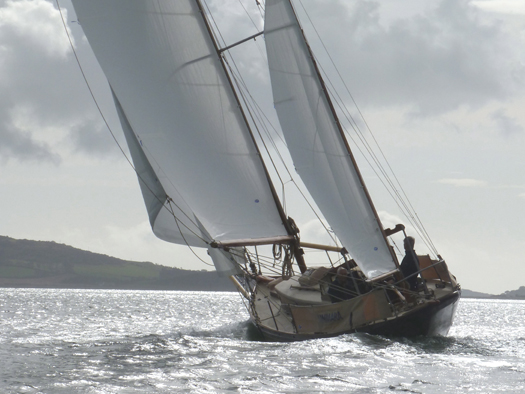 The Centenarian on a silver sea – after a restoration lasting 27 years, Ainmara deserved to spend her hundredth birthday at a very special place Photo: W M Nixon
The Centenarian on a silver sea – after a restoration lasting 27 years, Ainmara deserved to spend her hundredth birthday at a very special place Photo: W M Nixon
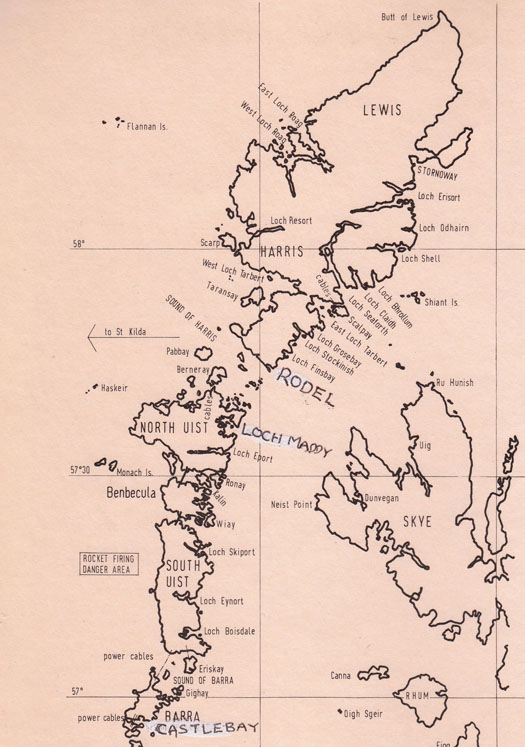 The cruise objective – Rodel is exactly in the middle of the long necklace of the Outer Hebrides
The cruise objective – Rodel is exactly in the middle of the long necklace of the Outer Hebrides
It's the sort of place that everyone thinks they are the first to discover, and my own first discovery of Rodel came in 1977 when we sailed in aboard Johnny Roche's 26ft South Coast OD Safina. The party in the inn was mighty, and dawn was already hinting when we struck a deal in the old kitchen to buy a bolt of Harris tweed, woven within sight of the anchorage. We sailed home with the tweed in a sailbag in the foc's'le, and two of the crew then commissioned that great Dublin tailor Jack O'Rourke (father of current Mermaid National Champion Jonathan O'Rourke) to make them up a couple of suits from our seafaring cloth.
Although they both were of much the same age, one was an old fogey from birth, while the other was a permanently young trendy. So when Jack finally produced the suits to their two very different and clearly defined specifications, it took a real effort to realize that both outfits were cut from the same piece of tweed, as one was a very sharp and fashionable bit of work, while the other had all the timeless style of a sack of potatoes.
Next time back to Rodel was six years later with my own Hustler 30 Turtle, and some of those good folk of Rodel with whom we'd partied in '77 had since gone to the great weaving mill in the sky, while the inn was running out of steam. It still clung to some semblance of gentility with immaculate table linen, but portions for dinner were of such modest size that we simply had two dinners apiece, one after the other.
That was all of thirty years ago, and since then the word was the inn had closed down completely. But a few years ago there was a welcome whisper of a restoration under completely new ownership. So when Ainmara's centenary came up the agenda, it seemed the perfect setting for a mid-cruise Centenary Dinner, and we departed from Ballycastle towards the sunny Hebrides with this interesting cruise objective in mind, while astern the Irish coast continued to lie under cloud.
Despite his impressive record of international long distance offshore racing, these days Dickie Gomes takes care to avoid unnecessary nights at sea, so our progress towards Rodel was gentle yet effective, hopping our way via Port Ellen and Ardbeg in Islay, then on to Scalasaig in Colonsay, and then out to Tiree to be nicely placed for the passage across the Sea of the Hebrides to Barra.
There'd been only one other yacht in Gott Bay in Tiree when we arrived, but there were half a dozen getting under way in leisurely style that morning. Ainmara was the only boat to head west out through Gunna Sound between Tiree and Coll into the Sea of the Hebrides, shaping our course for Barra and motoring gently through a large shoal of basking sharks going about their leisurely work. There was a strengthening breeze from the northeast and the soft grey cloud cover was melting away. It may have been three days already since leaving Ballycastle, but coming out through Gunna Sound gave a special feeling of the cruise really getting under way, and it settled into a perfect 40 mile passage, beam reaching in sunshine with everything set to the jib tops'l on its first outing, and the distinctive peaks of the southern outliers of the Western Isles starting to rise above the horizon while still thirty miles ahead.
 First port in the Outer Hebrides - Castlebay in Barra revelled in the August sunshine Photo: W M Nixon
First port in the Outer Hebrides - Castlebay in Barra revelled in the August sunshine Photo: W M Nixon
Castlebay basked in the sun, the heat was solid, and the tarmac on the quayside road was soft in the sun. At first we were in solitary splendour on the visitors mooring nearest Kisimul Castle, that ancient fortress of the MacNeils, but some other boats came in later in the evening. Up in the cool of the pub, glad to be out of the fierce sun, our gallant skipper met so many interesting folk that we were too late to get a booking at the funky little Café Kisimul on the quay, but had a reasonable meal in the hotel above the boat and retired aboard in a state of enchantment at being in the Outer Isles.
The morning brought a crisp easterly and hazy sunshine, so we were away early to make northing through the Sea of the Hebrides. We'd thought to drop into Eriskay for a lunch break, but the sailing was just too good, this was what we'd come for, we just kept going, and began to think that in a day or two we might even get to Rodel. Once the southeasterly headland on South Uist was astern, the sheets were eased and Ainmara settled into her stride with the jib tops'l pulling well, and the ancient mizzen staysail in its Killkenny colours of black and gold making its first appearance after a very long time in storage.
 This is what we came for – glorious sailing in the Sea of the Hebrides with the ancient mizzen staysail (in the Kilkenny colours) pulling well. Photo: W M Nixon
This is what we came for – glorious sailing in the Sea of the Hebrides with the ancient mizzen staysail (in the Kilkenny colours) pulling well. Photo: W M Nixon
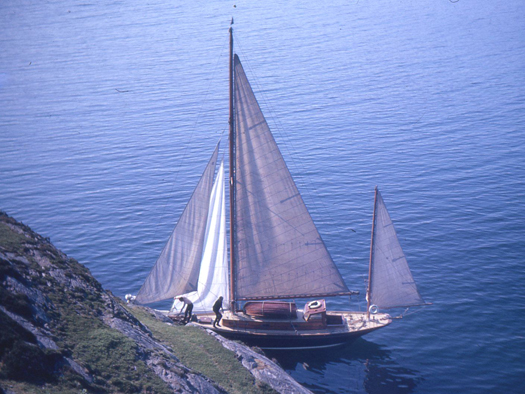 God be with the days.....Ainmara alongside the cliff at Loch Boisdale in June 1963 to collect a bunch of heather for the bowsprit end Photo: W M Nixon
God be with the days.....Ainmara alongside the cliff at Loch Boisdale in June 1963 to collect a bunch of heather for the bowsprit end Photo: W M Nixon
With progress like this, where on earth were we going to stop? Northward she romped, passing Loch Boisdale almost without a thought. Back in 1963 on our first cruise to the Outer Hebrides with Ainmara (when I already thought she was rather an old boat), one fine June morning we were gliding seawards down Loch Boiusdale, and noticed a healthy growth of heather on the nearby cliff. Once you've got north of Ardnmurchan Point, Scotland's Cape Horn, you're entitled to have a bundle of heather on the stemhead or bowsprit end. We hadn't yet got around to this back in 1963, but on that blissful morning we simply came alongside the steep shore, and nipped up the cliff to get the heather. It was Monday June 10th 1963. It was with some relief at the end of June that we noted the exact Golden Jubilee of that magic morning on Monday June 10th 2013 had passed entirely unmarked. You can have enough of Golden Jubilees.
Onward we sailed in August 2012 with gems of lochs like Eynort, Skipport and Uiskkevagh slipping by as this perfect day progressed. Flodday likewise was missed with cavalier disregard, then by Eport the wind was gone, but we motored on to Loch Maddy (48 miles from Castlebay) as we'd never been there before, and it left barely a dozen miles next day to Rodel.
We liked Loch Maddy, it's very Western Isles with the pier in one place and the village in another, and in the morning there was time for an heroic breakfast before heading down the loch in bright sunshine. There was a fine easterly breeze, and out in open water all plain sail was set and we started making impressive knots towards Rodel. I foolishly remarked that this looked like being the best sail of the cruise. Within minutes, it was as if somebody had knocked off a switch. We'd to motor for a while, then a gentle nor'easter had us beating in very leisurely style, and in mid-afternoon we were off Rodel with an hour or so to go to high water.
 While Loch Rodel itself provides only limited shelter, the pool behind Vallay Island is snug
While Loch Rodel itself provides only limited shelter, the pool behind Vallay Island is snug  The tidal entrance looks tricky enough, but it's worth it for the perfect anchorage within
The tidal entrance looks tricky enough, but it's worth it for the perfect anchorage within 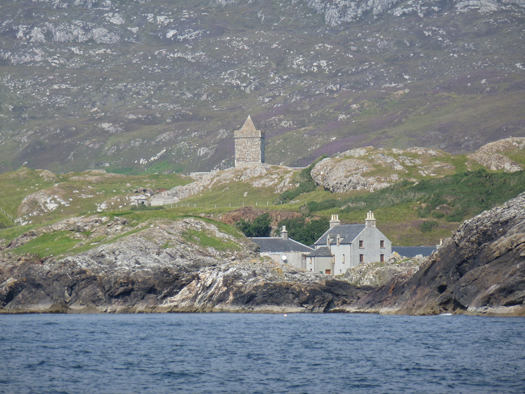 The shoreline begins to take shape, with St Clements Church clear above the hotel at Rodel Photo: W M Nixon
The shoreline begins to take shape, with St Clements Church clear above the hotel at Rodel Photo: W M Nixon
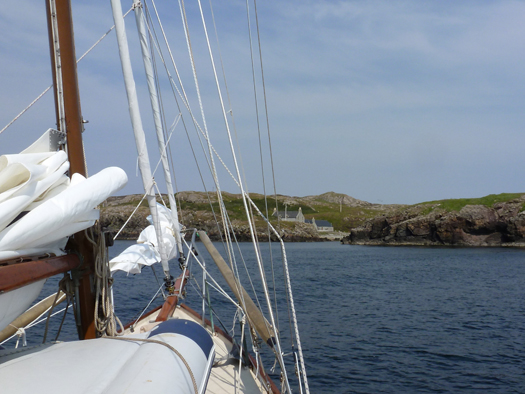 Ainmara is lining up for the Bay Channel into the pool Photo: W M Nixon
Ainmara is lining up for the Bay Channel into the pool Photo: W M Nixon
 The seabed is clearly visible as you pass through the channel close to the port hand marker Photo: W M Nixon
The seabed is clearly visible as you pass through the channel close to the port hand marker Photo: W M Nixon
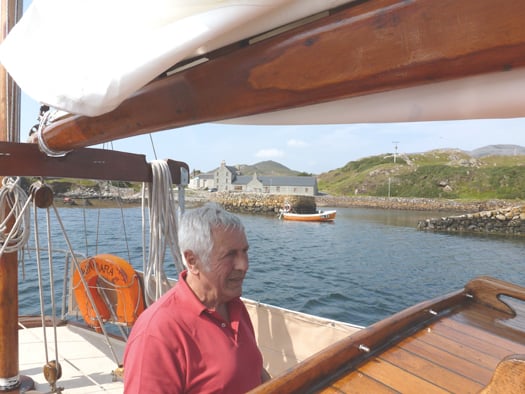 A very relieved skipper as we start to find deeper water in the pool Photo: W M Nixon
A very relieved skipper as we start to find deeper water in the pool Photo: W M Nixon
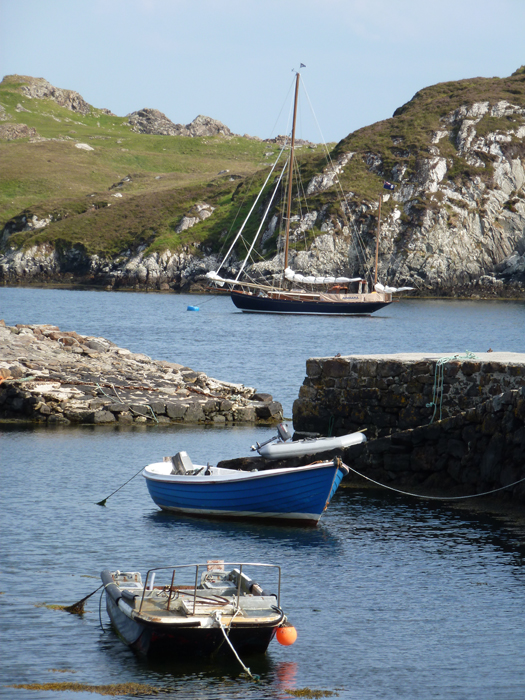 Mission accomplished – Ainmara in Rodel to celebrate her Centenary Photo: W M Nixon
Mission accomplished – Ainmara in Rodel to celebrate her Centenary Photo: W M Nixon
But as tides were neaps, the skipper was a bit nervous as we found our way through the shoal entrance in gentle style. You really do pass very close to the port hand marker. Yet once within the pool, my shipmates saw why I was so keen about this enchanting place, and we happily slowed down to Rodel speed for the rest of the day.
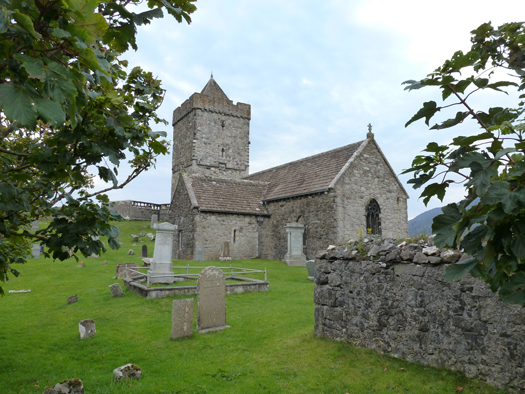 St Clement's Church at Rodel is one of the Outer Hebrides more significant buildings Photo: W M Nixon
St Clement's Church at Rodel is one of the Outer Hebrides more significant buildings Photo: W M Nixon The historic Macleod tomb in St Clement's Photo: W M Nixon
The historic Macleod tomb in St Clement's Photo: W M Nixon
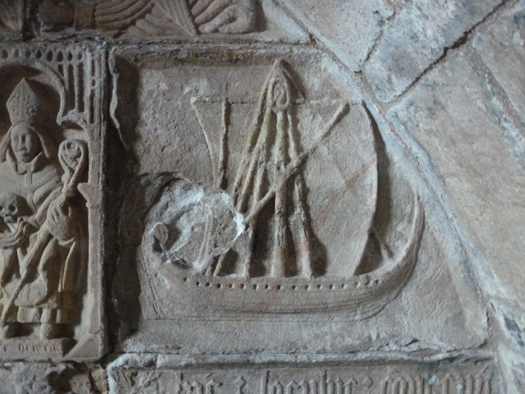 The stone carving on the MacLeod tomb which inspired the Lord of the Isles galley to be built in Greencastle in Donegal Photo: W M Nixon
The stone carving on the MacLeod tomb which inspired the Lord of the Isles galley to be built in Greencastle in Donegal Photo: W M Nixon
Ashore, a visit to St Clements Church fitted the mood perfectly. There is a genuine sense of the past, and of the turbulent history which had once been the lot of this sleepy and now remote place. Down at the restored inn (it's called the Rodel Hotel these days, but for me it will always be the inn), we found the sympathetically-renovated establishment had a new dining room beside a new bar – the old rough bar out the back where we'd started negotiating for the tweed was long gone. And though the Countess of Dunmore's drawing room cum dining room where we'd enjoyed fine linen still exists, it is boarded up. But everything else is very much alive, we were able to have luxurious baths in Jock's Room (thanks Jock) and the setting was perfect with the evening sun still bright on the Centenarian sitting gracefully on her mooring and well visible through the restaurant windows, while the food aspirations were up to speed with a German chef and a friendly and obliging Spanish husband and wife couple front of house.
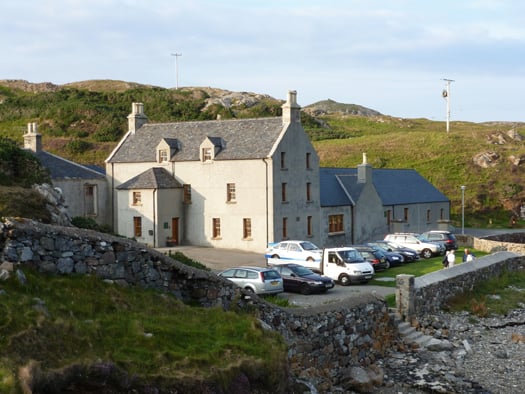 The Rodel Hotel has been restored in a manner which respects its original style. Photo: W M Nixon
The Rodel Hotel has been restored in a manner which respects its original style. Photo: W M Nixon
Appropriately, the skipper had the best of it - he went for the surf'n'turf option which was far from your usual beef and salmon, it was Pabbay venison from the second-last island before St Kilda, combined with Sound of Harris hand-caught scallops. It sounds a bit overpowering, but worked very well, and kept himself in the best of spirits. Denis our third crewman being a sports addict, he was keen to see the Olympics Closing Ceremony on television after dinner, and we were invited to use the Residents' Lounge to do so in comfort. While the lads were settling themselves in there with the coffees and digestifs, I nipped furtively up to the bar to settle the bill - the other two hadn't really believed my "get to Rodel and I'll pay for dinner" proposal - and found what was clearly the man himself running the bar and everything else.
"Would you be our host?" I enquired. "I am indeed," said he, "for my sins I'm the proprietor of this place. Welcome to Rodel. I'm Donald MacDonald".
Such is life. We go all the way, nursing an old boat across hundreds of miles of potentially very turbulent water to Rodel in the Western Isles in order to celebrate her Centenary Feast in the Great Hall of the MacLeods of Harris, only to find it has become a MacDonald's.
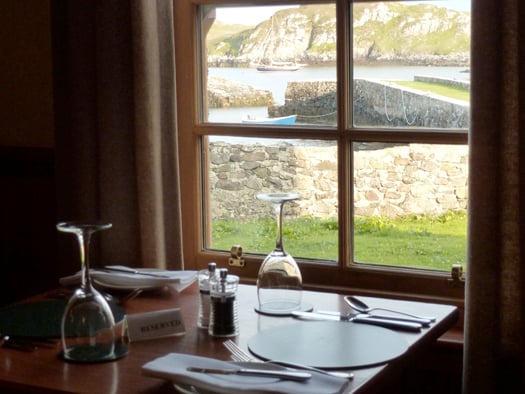 A MacDonald's with a difference – Ainmara serene in the evening sunshine at Poll an Tigh-Mhail, seen from the dining room in the Rodel Hotel. Photo: W M Nixon
A MacDonald's with a difference – Ainmara serene in the evening sunshine at Poll an Tigh-Mhail, seen from the dining room in the Rodel Hotel. Photo: W M Nixon
This article was first published on Afloat on July 27, 2013
The Cruising Club of America couldn't hand out its 2020 awards in person, so the club made it a special event and gathered a pantheon of great sailors on Zoom.
In early March in a normal year, Cruising Club of America members visit the New York Yacht Club in Manhattan for a weekend of meetings featuring an Awards dinner to recognize more than half a dozen worthy sailors as recipients of the club’s major awards. The pomp and circumstance of that event had to be adapted to a virtual space this year, starting with an hour-long presentation, largely pre-recorded, followed by a longer breakout-room segment in which members conversed with the winners in real-time.
As it turned out, sailing royalty showed up from all over the globe, including six previous winners of the Blue Water Medal: Jean Luc Van Den Heede (2019), Skip Novak (2014), Jeanne Socrates (2013), Peter Passano (2007), Tony Gooch (2003), and Bob and Beth Lux (1996). They provided a great welcome reception for the 2020 winner Randall Reeves.
In accepting his award, Reeves said he had had a great deal of good luck, starting with marrying his wife Joanna, who buoyed him up despite “resounding failures.” He also credited his luck at finding the right vessel for the trip, his 45-foot aluminium cutter Moli, “a boat fast enough and big enough, simple enough that I could handle it and fix what broke, yet strong enough to handle divergent requisites of big seas in the south and ice in the north.” He also credited former owner and Blue Water Medal winner Tony Gooch: “He was my living and breathing owners manual.”
Six-time circumnavigator Van Den Heede, who was unable to receive the 2019 award in person due to health reasons, said, “I started sailing because I read books. The first book I had the pleasure to read was by Alain Gerbault, the first man to get this medal [in 1923].” Van Den Heede said he was honoured to follow Gerbault and all the others who received the medal, adding, “these people are legends and I'm surprised to join them.”
 Blue Water Medal Winner Jean-Luc Van Den Heede
Blue Water Medal Winner Jean-Luc Van Den Heede
2020 Cruising Club of America Award Winners
Randall Reeves—Blue Water Medal
Christian Charalambous—Rod Stephens Seamanship Trophy
Calypso Romero/Adrien Koller—Young Voyager Award
Stephen Brown—Far Horizons Medal
Salty Dawg Sailing Association—Special Recognition Award
Simon and Sally Currin—Royal Cruising Club Trophy
Alan K. Forsythe—Charles H. Vilas Literary Prize
Peter L. Chandler—Richard S. Nye Trophy
A survey carried out amongst Cruising Association (CA) members who keep their boats on the rivers and canals of Schengen countries has revealed that 80% are likely to sell their boats and give up cruising altogether, or move their base to a non-Schengen country.
Overall figures for coastal cruising boat owners are expected to be broadly similar although with more sailing out of Schengen waters to other cruising grounds.
The failure of the UK government to negotiate a fair deal with the EU means that UK citizens can now only visit Schengen countries for 90 days in every 180, making it impossible for boat owners to spend a whole season exploring Europe’s coasts and inland waterways.
The CA says that this flies in the face of Britain’s maritime heritage and shrinks the country’s pool of experienced, adventurous sailors. The CA’s President, Julian Dussek, is very concerned, stating:
"It will weaken the long-standing cultural ties between UK and EU boating communities, and damage efforts to rebuild tourism post- Covid. The knock-on effects could do serious damage to UK boat sales and the British marine industry in general.
“Unless we can find practical ways of overcoming this debilitating 90-day rule, British flagged boats will become a rare sight in Schengen waters. For a proud seafaring nation, this would be a real tragedy.”
Sir Robin Knox-Johnston, Patron of the Cruising Association, recently called on The Rt Hon Oliver Dowden CBE MP, Secretary of State for Digital, Culture, Media and Sport, to step in to resolve the difficulties now facing the approximately 30,000 British sailors who currently keep their boats in EU waters, and who are facing this threat to long-distance cruising.
The 180-Day Campaign is gathering pace, with new members signing up to the Association in support of its efforts.
The CA is the largest UK organisation focussed solely on supporting extended cruising in small boats. It recently launched a 180-day Visa Campaign to encourage individual EU states to reciprocate the British provision to allow EU citizens to spend 180 days per visit in the UK by making long stay visas available to UK boating visitors.
Cruising Association Launches 180-Day Visa Campaign to Reduce Brexit Impact on British Small Boat Cruisers
The Cruising Association has today launched its campaign to reduce the impact of Brexit on British small boat cruisers who have traditionally explored the coasts and inland waterways of Europe in sailing and motor boats.
There's a particular focus on the Netherlands, Greece, Spain and Portugal where the CA is lobbying for a 180-day cruising visa separate from the Schengen 90-day visa. The CA is also exploring opportunities for a simplified application process to the existing long-term tourist visas available for France and Sweden.
Along with other groups such as second homeowners, professional musicians, academics, etc. the CA has previously tried to engage with MPs and Ministers on this issue but, thus far, and with the COVID pandemic taking priority, there has been little will to address the 90/180 problem in the corridors of Westminster.
EU rules allow individual EU countries to issue long-term visas and a recent report that the Government is now considering addressing the problems for professional musicians is encouraging. The CA is making the case that any solution should also cover sailing and motorboat cruising.
In a well-crafted letter from the CA's Patron, Sir Robin Knox-Johnston, addressed to The Rt Hon Oliver Dowden CBE MP, Secretary of State, Department of Digital, Culture, Media and Sport, Sir Robin puts forward the CA's argument that the Schengen 90 days in 180 limit, that now applies to UK citizens, will cause severe difficulties and is unfair.
Each EU member country can set its own policy for visas and permits of more than 90 days, hence the CA has its 'local' teams working out the best strategy for each country.
More on this story and the full text of Sir Robin's letter to the Secretary of State here
Irish Cruising Club Fly the Flag for Responsible Cruising
The Irish Cruising Club has been producing a printed Annual collating its members doings afloat and ashore through logs and narratives for ninety years now. And while these days this substantial collection is in circulation before Christmas as a matter of course - thanks to the succession of Honorary Editors being notably on top of production technology and sticking to a rather fierce deadline - it isn't until after the Club's AGM in February that any of it goes public, following which the many logs – and particularly the award-winning ones – are available online on the club's website.
Time was when the keeping of a proper log was de rigeur - effectively a legal requirement - on any cruising boat. So these days, when many "logs" are often no more than electronic data in a chart plotter, the leading cruising organisations' encouragement of the keeping of real logs – comprehensive productions which are in effect informative and entertaining journals - adds depth and quality to the development of cruising and our knowledge of cruising areas, whether popular or remote.
Last night ICC Commodore David Beattie presided over the AGM as a Zoom session, and while he'd to acknowledge a frustrating year in terms of members meeting personally other than in small socially-compliant groups and bubbles, the latest Annual – all 200 pages of it – speaks volumes for the members' energy in making the best of 2020's pandemic-limited cruising possibilities, that is when they could manage to get all their organisational and time-availability ducks in a row.
 Colm O Lochlainn in Howth aboard his 9-ton yawl Klysma in the 1920s. A man of many parts, he was a sailor, printer, folklorist, and traditional musician who for many years was a professor in UCD.
Colm O Lochlainn in Howth aboard his 9-ton yawl Klysma in the 1920s. A man of many parts, he was a sailor, printer, folklorist, and traditional musician who for many years was a professor in UCD.
Others responded to Annual editor Maire Breathnach of Dungarvan's request for virtually anything of interest to cruising folk, and the result is an entertaining mix of contemporary cruising logs, waves of nostalgia, and off-the-wall items in keeping with the club's ethos of taking itself seriously when matters of seamanship, sailing directions, and safety and regulation-compliance are concerned, but at other times not taking itself too seriously at all.
That said, the status of the Annual is almost sacred. For its first ten years or so in the 1930s, it was quality printed by one of the earliest members (and owner of the 9-tonner Klysma), the noted Gaelic scholar, folklorist and traditional music collector Colm O Lochlainn (1892 – 1972), whose many interests included his specialist printing company, the Three Candles Press.
Links to contemporary creativity were reinforced by one of those who made a significant input into the layout and illustrations being the club's first Honorary Treasurer, Billy McBride, whose day job was as an artist in the world-renowned Harry Clarke Stained Glass studios in Dublin.
 A Billy McBride sketch of Espanola, the 15-ton cutter owned by Herbert Wright, founding Commodore in 1929 of the Irish Cruising Club
A Billy McBride sketch of Espanola, the 15-ton cutter owned by Herbert Wright, founding Commodore in 1929 of the Irish Cruising Club
Admittedly these high production standards couldn't always be retained in some subsequent years when the Irish economy was in poor health. But for many years now they've been more than equalled, and Maire Breathnach has not only raised the standards even higher, but she gives us a fresh link back to the days when Colm O Lochlainn used to serenade the members in to dinner on the uilleann pipes. For Maire is a dab hand on the concertina to professional level, and one of her contributions to the Annual is some recollections of a clockwise solo cruise round Ireland from Dungarvan in 1995 in her Seamaster 23 Shackler, when her traditional musical talents made for a very effective calling card in many ports.
 Marie Breathnach's Seamaster 23 Shackler at Barnaderg under Diamond Hill in Connemara during her 1995 solo Round Ireland Cruise
Marie Breathnach's Seamaster 23 Shackler at Barnaderg under Diamond Hill in Connemara during her 1995 solo Round Ireland Cruise
These days she and husband Andrew Wilkes sail a very different proposition to the handy little Shackler – their ship is the 64ft steel-built gaff-rigged pilot-cutter type Annabel J, which is sometimes seen gracing the waterfront in Waterford at Reginald's Tower when they're at home in Dungarvan. For although the pool just below Dungarvan bridge could take their previous smaller gaffer Young Larry, for Annabel J it has to be Waterford.
 The 64ft cutter Annabel J at Reginald's Tower in Waterford. Photo: Norman Kean
The 64ft cutter Annabel J at Reginald's Tower in Waterford. Photo: Norman Kean
They've been having quite the time since they last departed from that historic port in the Autumn of 2019, as pre-COVID their plan was to make a circuit of South America, which they last did in 2004 with the Swan 42 King of Hearts, thereby seeing Maire receive the ICC's premier award, the Faulkner Cup.
King of Heart's circuit of South America was not without its challenges, but with Annabel J they have to be prepared to deal with problems unknown to owners of modern craft, and in checking aloft while at Madeira on the southward passage, Andrew discovered some rot at the topmost sheave near the head of the pole mast.
Knowing the limitations of repair facilities available at Madeira as they'd been delayed there in getting their hefty big broken tiller replaced, they reckoned the best option was to nurse the boat to the more extensive facilities in the Canaries. And though the head of the mast did indeed give up the ghost, it only deprived them of the use of the topsail and the flying jib, and under the lower sails with skilled seamanship they brought Annabel J to Lanzarote in November 2019. There, Andrew started on the work of making the new upper section for the mast, while Maire was busy with the final editing push on the ICC Annual for 2019.
 The ICC Annual for 2020, like that of 2019, was produced by editor Maire Breathnach while on the move. Cover image is aboard Derek Jones' Najad 44 Narnia from Strangford Lough in the Sound of Mull. Photo: David Stewart
The ICC Annual for 2020, like that of 2019, was produced by editor Maire Breathnach while on the move. Cover image is aboard Derek Jones' Najad 44 Narnia from Strangford Lough in the Sound of Mull. Photo: David Stewart
Clearly these people are operating in a different league to the rest of us, but by the time the massive rig was fully operational again, they were pandemic-trapped for two months in port with the strictly-enforced "Confinamiento". Yet by knowing that it was going to happen, Andrew had stocked up on varnish and paint to make the best of the Canaries' perfect fitting-out climate, and Annabel J emerged from the Confinamiento looking trimmer than ever, while Maire had advanced her fiddle-playing ability through Zoom classes with Niamh Dunne back in Ireland.
But though the lockdown had been lifted within the Canaries, "within" was the key word, so they made a virtue out of their limited options and cruised the islands in fascinating detail, resulting in a very complete log which adjudicator John Clementson reckoned was worthy of the ICC's Rockabill Trophy for Seamanship in recognition of the way the twosome on Annabel J had dealt with the collapsed upper mast, and then put things right so effectively that they created a fine cruise within 2020's limitations.
EXCEPTIONAL FAMILY CRUISE HONOURED
Yet it says everything about the spirit of the ICC in 2020's difficult conditions that another oceanic cruise narrated by a female co-skipper should win the ICC's premier trophy, the Faulkner Cup, which dates back to 1931. This special venture was the Atlantic circuit cruise from Galway Bay in the 43ft steel ketch Danu by Vera Quinlan and Peter Owens and their children Lilian and Ruari, a cruise which – despite being limited by restrictions from time to time - was completed in the summer at Parkmore near Kinvara to to make this family crew Ireland's Sailors of the Month for July, and subsequently they were also presented with Galway Bay SC's top cruising trophy.
 When the going was good – Danu in the Caribbean
When the going was good – Danu in the Caribbean
But now with the Faulkner Cup – awarded three times in a row in 2010, 2011 and 2012 to Vera's father Fergus Quinlan and his wife Kay for their global circumnavigation with their own-built 12m steel cutter Pylades – they have, so to speak, received the favourable Supreme Court judgment, and it is based on a wonderful log which gives us a real insight into the challenges and rewards of intensive family cruising, while handling the added exacerbation of the pandemic problems.
For a proper cruise should be something of a work of art, rather than a continuing process of box-ticking, and with Vera being an oceanographer while Peter is a mountaineer, the cruise of Danu was indeed a matter of green days in forests and blue days at sea, with mountaineering and desert-crossing expeditions and island-hopping adding to the mixture, such that while Lilian and Ruari - 11 and 9 when the cruise got under way – had started out as decidedly switched-on kids to begin with, they were in a league of their own in the "cool as you like" stakes when they returned.
 Settling into the cruising routine – Ruari and Lilian paddleboarding in the Isles of Scilly, Danu's first stop on the outward passage from Ireland
Settling into the cruising routine – Ruari and Lilian paddleboarding in the Isles of Scilly, Danu's first stop on the outward passage from Ireland
 Broadening the scope – Ruari and Lilian with their father Peter climbing in the Picos de Europa in Northern Spain. Photo: Vera Quinlan
Broadening the scope – Ruari and Lilian with their father Peter climbing in the Picos de Europa in Northern Spain. Photo: Vera Quinlan
 Shore visit with a difference – Lilian and Ruari on the Sands of Merguza in Morocco. Photo: Vera Quinlan
Shore visit with a difference – Lilian and Ruari on the Sands of Merguza in Morocco. Photo: Vera Quinlan
 "A man needs his own place….." – Ruari in his secret lair in the sail-stack aboard Danu. Photo: Vera Quinlan
"A man needs his own place….." – Ruari in his secret lair in the sail-stack aboard Danu. Photo: Vera Quinlan
Over the years the Irish Cruising Club has accumulated an almost embarrassing array of trophies, yet in a normal year the club's members are so wide-ranging on an almost global scale that each trophy usually finds a home at the annual awards ceremony. But out of respect for the frustrations through compliance-restriction which many experienced during 2020, adjudicator John Clementson reduced the awards to nine, two of which we've already mentioned, but here's the total list:
Irish Cruising Club Awards (ICC) Awards 2020
- Faulkner Cup: Danu (Mauritius 43, Vera Quinlan & Peter Owens), Family cruise for Atlantic circuit
- Rockabill Trophy for Seamanship: Annabel J (64ft gaff cutter, Maire Breathnach)
- Round Ireland Cup: L'Iroise (38ft 1966 wooden ketch) Paddy Barry)
- Fortnight Cup: Agathos (Jeanneau 45, Mick Delap) Three generations cruise in two weeks in Greece's Aeolian Isles
- Perry Greer Bowl for best first log: Dame de Jade (Beneteau 312, Sally Cudmore) Detailed family cruising off south and southwest coasts of Ireland (Also Fingal Cup for Judge's favourite log).
- Glengarriff Trophy for special cruise in Irish waters: Pylades (van de Stadt 12m cutter, Fergus & Kay Quinlan) detailed cruise Galway Bay to Bantry and return.
- Marie Trophy for best cruise by boat under 30ft LOA: Calico Jack (Sadler 25, Conor O'Byrne) Detailed cruise from Galway to entire coast of Connacht.
- Wild Goose Trophy for best log of literary merit: Margie Crawford for account of cruise to Antarctica in Tall Ship Europa
- John B Kearney Cup for Services to Sailing: Stanton Adair (Commodore ICC 2017-2020)
When we remember that Paddy Barry has been awarded the Cruising Club of America's Blue Water Medal for his oceanic voyaging, and that in times past Conor O'Byrne received the Marie Trophy for a very competent hop from Galway to St Kilda and back in his little 25-footer Calico Jack, then we get some notion of how most cruising people's activities have been restricted in 2020. But in both cases, and in many other logs in the Annual, instead of grumbling they just got on with it and made the best of what was permissible.
 The veteran Glenans ketch L'Iroise at Clifden during her circuit of Ireland
The veteran Glenans ketch L'Iroise at Clifden during her circuit of Ireland
In Paddy's case, it was a matter of bringing the former Glenans ketch L'Iroise back to life with owner Seamus O'Byrne, and sailing on an entertaining Ireland-circling cruise in which, despite social-distancing and whatever, they had an experience of which the adjudicator approvingly noted that: "Paddy doesn't just voyage – he goes to places and to people", such that with his many interests in classic boats, traditional music and folklore generally, it all makes for an extraordinarily entertaining narrative.
Another unusual take on the limitations of 2020 was provided by ICC Sailing Directions Editor Norman Kean and his wife Geraldine Hennigan with their Warrior 40 Coire Uisge. They reckoned the best way to comply with the limitations was to visit every uninhabited island or people-less anchorage between their home port of Courtmacsherry and Valentia Island, and thanks to having grown-up equipment to handle their ample ground tackle, they'd a surprisingly varied cruise, the most appropriate stopover being at Quarantine island near Baltimore, a somewhat spooky place, as a walk ashore suggests that not everyone put onto it survived quarantine.
 Just the place to be in 2020 – Coire Uisge anchored off Quarantine Island in the western channel to Baltimore. Photo: Norman Kean
Just the place to be in 2020 – Coire Uisge anchored off Quarantine Island in the western channel to Baltimore. Photo: Norman Kean
A landing on a very uninhabited island way back in 1975 is recalled in the Annual by William Dick, who was the crewman from Paul Campbell's 37ft yawl Verve who managed to leap ashore and clamber up Rockall in what was a first for any cruising boat. These days the anomalous status of Rockall is of increasing significance, so it's ironic that though it was an Irish boat which made this first landing, both the owner-skipper and the intrepid climber who got to the peak happened to have Scottish surnames……
 William Dick landing on Rockall in 1975, with the dinghy from Paul Campbell's Verve from Dun Laoghaire being rowed by the late Mickey d'Alton
William Dick landing on Rockall in 1975, with the dinghy from Paul Campbell's Verve from Dun Laoghaire being rowed by the late Mickey d'Alton
There are several voyages into history in this fine Annual, and one of the most entertaining has to be Ed Wheeler's account of a cruise – either single-handed "or I might as well have been single-handed" – in the 26ft gaff sloop Calabar from Sydney north and west along the coasts of Australia to Darwin in 1971.
This had its origins in 1968 when Ed sailed with us in the 25ft Vertue cutter ice Bird out to Spain where, as funds were getting low, he took the offer of being a deck-hand on a former Liberty ship making her way –with many delays – out to China for scrap.
We'd time for an entertaining cruise eastward along the North Coast of Spain before this ship finally departed from Coruna, and while I sailed Ice Bird single-handed back to Ireland in very leisurely stages via Brittany and Cornwall, Ed found his voyage to China was also going forward in very leisurely stages dictated by endless breakdowns, with a guaranteed three weeks money-maker becoming a six months marathon at the end of which he'd the greatest difficulty in getting paid at all.
From Shanghai he ended up in Australia – as one does – building new highways in the Northern Territories for a 22-stone boss who was naturally known as the Colossus of Roads. Thus Ed amassed enough cash to buy this little boat in Sydney, which he re-named Calabar after the legendary song-celebrated barge on the Lagan Canal, and after an incident-filled cruise he sold her in Darwin and gradually wended his way back to Ireland.
 And it all started with a little cruise to Spain…..The 26ft Calabar, which Ed Wheeler cruised along the Australian coast from Sydney to Darwin in 1971. Illustration by Pete Adams
And it all started with a little cruise to Spain…..The 26ft Calabar, which Ed Wheeler cruised along the Australian coast from Sydney to Darwin in 1971. Illustration by Pete Adams
Having bid each other farewell at the pierhead of San Sebastian in July 1968 as Ice Bird and I headed north for the delights of Brittany and Cornwall, by a series of extraordinary coincidences we didn't meet again – and totally unexpected at that - until February 1972 in Salthill in Galway, where I was booked into the hotel to show the newly-formed and very keen Galway Bay Sailing Club the film of a cruise to Iceland with Ice bird in 1967.
The extraordinary serendipity of meeting my old shipmate so totally out of the blue after four years, and in Salthill of all places, had a somewhat de-railing effect on the evening's smooth progress. When we finally got the 16mm movie up and running, for some reason the boat was sailing backwards, and there were distinct vehicle tyre-treads across some of the images.
So the full story of what happened in Salthill in 1972 had better stay in Salthill, and be gently put back to sleep with all those other memories evoked by the excellent Irish Cruising Club Annual of 2020. It's a publication that successfully demonstrates what could be done while being COVID-compliant in the relevant regulations, while at the same time making everyone mustard keen to get back to unfettered cruising just as soon as possible. Maire Breathnach deserves all congratulations for making it happen.
Beacon of Hope Sailing Project Launches a Round the World Yacht Race World Record Attempt
Tuesday 9 February 2021 will see the launch of the UK's Beacon of Hope Sailing Project's ambitious and unique circumnavigation of the globe. The crew of sailors, all of whom have been through life-changing experiences or illness, will attempt to achieve at least two world records on their incredible journey. Firstly the fastest non-professional team to circumnavigate the globe against wind and currents in the wrong direction. Secondly the fastest Atlantic Crossing for a Farr 65 yacht.
The team of 10 team members will depart from Cowes on their 38,000 nautical mile journey in June 2022. The project founded by Aaron Baxter, 21, from Gosport, Thomas Miles, 21, of Newport and Matthew Harris 53, all of whom have been through life-changing illnesses, will take them through ten countries including, St Lucia, the Falkland Islands, The U.S.A., New Zealand and South Africa.
The team will co-ordinate with various charities en route, including the Just One Ocean conservation project based at the University of Portsmouth. The Beacon of Hope's Sailing project was created to support those who have endured traumatic life events and to help them to launch their own journeys into a new and confident life. It aims to demonstrate the healing effects of sailing on both mental and physical health by promoting growth in independence.
"After I had medically recovered from my illness, I was expected to move forward with my life immediately, be able to explain to my employers and friends what I'd been through as well as obtaining a new job straight away in order to live. I found this very difficult. I needed an opportunity to reflect on what I had actually just gone through and to plan how to get back on track. " – Thomas Miles – Co-founder
The vessel selected for the journey is 'Albatross II' a Farr 65 designed by Bruce Farr, previously known as the 'Spirit of Diana', one of only 5 vessels built at the cost of $1 million each to compete in the Millennium Round the World Yacht Race from 1999-2000. During their first round of fundraising from sponsors, members of the public and continuous partnerships the team will purchase and undertake the extensive refit of the vessel in order to make the vessel suitable for both the purpose of the training and the race.
Following the race, the Beacon of Hope Sailing Project C.I.C. plans to establish a base on the Isle of Wight as a lasting legacy of their journey. The team will continue to enter the vessel into regattas and races such as the Round the Island Race, the Fastnet, and, in time, even larger races such as the Vendee Globe. From this base they will offer sailing and water-sports activates, helping people on their journey of recovery also offering practical, workshops to support people on a return to a fuller life as well as the base for the race team.




























